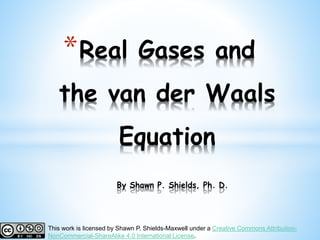
Chem II - Real Gases: Van der Waals (Liquids and Solids)
- 1. *Real Gases and the van der Waals Equation By Shawn P. Shields, Ph. D. This work is licensed by Shawn P. Shields-Maxwell under a Creative Commons Attribution- NonCommercial-ShareAlike 4.0 International License.
- 2. *Real Gases…What are they? *Most gases behave ideally when they are held at low pressures and “high” temperatures. (Room temperature is considered high T.) *Remember that “ideal behavior” means that the gas molecules do not interact with each other. Only kinetic energy is present.
- 3. *Real Gases…What are they? *However, sometimes gas molecules DO interact with each other. *Interactions between gas molecules is more likely at *low temperatures *high gas pressures (i.e., high gas densities). This introduces potential energy into the picture!
- 4. *Real Gases…What are they? * Molecules that have significant intermolecular attractions (aka “polar” molecules) may also interact with each other. + “partial charges” on the molecules are attracted to each other Water is a polar molecule.
- 5. *The Compressibility Factor, Z *We can use the “compressibility factor” (Z) to detect deviations of a gas from ideal behavior in experiments. 𝐙 = 𝐏𝐕 𝐧𝐑𝐓 *When Z < 1, intermolecular attractions exist, and gas molecules can “feel” each other’s presence.
- 6. *Real Gas Behavior Compare 3 scenarios for gases in a piston… The first piston shows a gas at low pressure. Vactual = Videal Ideal Gas Law and KTG are obeyed. Low P
- 7. *Real Gas Behavior The second piston shows a gas at med-high pressure. As the volume decreases, some molecules stick together, effectively reducing the moles of gas. Now, Vactual < Videal The gas is more compressible, and attractions dominate! Med to high P
- 8. *Real Gas Behavior Compare 3 scenarios for gases in a piston… The third piston shows a gas at REALLY high pressure. The gas cannot move and we see that it actually DOES take up space…as our common sense might tell us. Now, Vactual > Videal Repulsions dominate! Ridiculously high P
- 9. *The Compressibility Factor, Z *More about the compressibility factor Z Z = 1 𝒁 = 𝑷𝑽 𝒏𝑹𝑻 P (atm) Perfectly ideal gas behavior Real gases Behaves as an ideal gas under reasonable conditions Attractions dominate Repulsions dominate
- 10. *The van der Waals Equation *Corrects the Ideal Gas Law for real gas behavior. 𝑃 = 𝑛𝑅𝑇 𝑉 − 𝑛𝑏 − 𝑎𝑛2 𝑉2 *The van der Waals constants a and b are experimentally-determined for each individual gas. *The vdw constant a describes the strength of attractions with units L2 atm mole–2 *The vdw constant b increases with increasing molecular size with units L mol–1
- 11. *The van der Waals Equation *Corrects the Ideal Gas Law for real gas behavior. 𝑃 = 𝑛𝑅𝑇 𝑉 − 𝑛𝑏 − 𝑎𝑛2 𝑉2 Correction for the volume taken up by the gas molecules Correction for the attractions between gas molecules. The actual pressure P is reduced by this amount compared to the Ideal Gas law.
- 12. *The van der Waals Equation *Predict the relative size of the van der Waals constants for the following gases: H2 gas (very small and not polar) SO2 gas (larger atoms and polar) 𝑃 = 𝑛𝑅𝑇 𝑉 − 𝑛𝑏 − 𝑎𝑛2 𝑉2
- 13. *The van der Waals Equation *Predict the relative size of the van der waals constants for the following gases: H2 gas (very small and not polar) SO2 gas (larger atoms and polar) The vdw constant a and b would both be larger for SO2 gas.
- 14. *The van der Waals Equation *Which gas would produce the lowest pressure, with moles, T and V constant? CH4 (methane) gas (small molecule and not polar) H2O gas (small molecules and polar) 𝑃 = 𝑛𝑅𝑇 𝑉 − 𝑛𝑏 − 𝑎𝑛2 𝑉2
- 15. *The van der Waals Equation *Which gas would produce the lowest pressure, with moles, T and V constant? 𝑃 = 𝑛𝑅𝑇 𝑉 − 𝑛𝑏 − 𝑎𝑛2 𝑉2 If CH4 is a small molecule, and not polar, this means that a and b are both relatively small. (a = 2.25, b = 0.0428) The gas should behave close to ideally. If H2O gas is also a small molecule, then the vdw constant b will be of a similar size. However, since water is polar, the vdw constant a will be quite a bit larger. (a = 5.46, b = 0.0305) The pressure exerted by water will be lower than the ideal pressure.
- 16. *Summary *Real gases interact with each other and take up volume in the container. *The van der Waals equation corrects the Ideal Gas Law for real gas behavior. 𝑃 = 𝑛𝑅𝑇 𝑉 − 𝑛𝑏 − 𝑎𝑛2 𝑉2 If the gas is under ideal gas conditions, the van der Waals equation reduces to the Ideal Gas Law PV=nRT (Try this by making a and b = 0)
